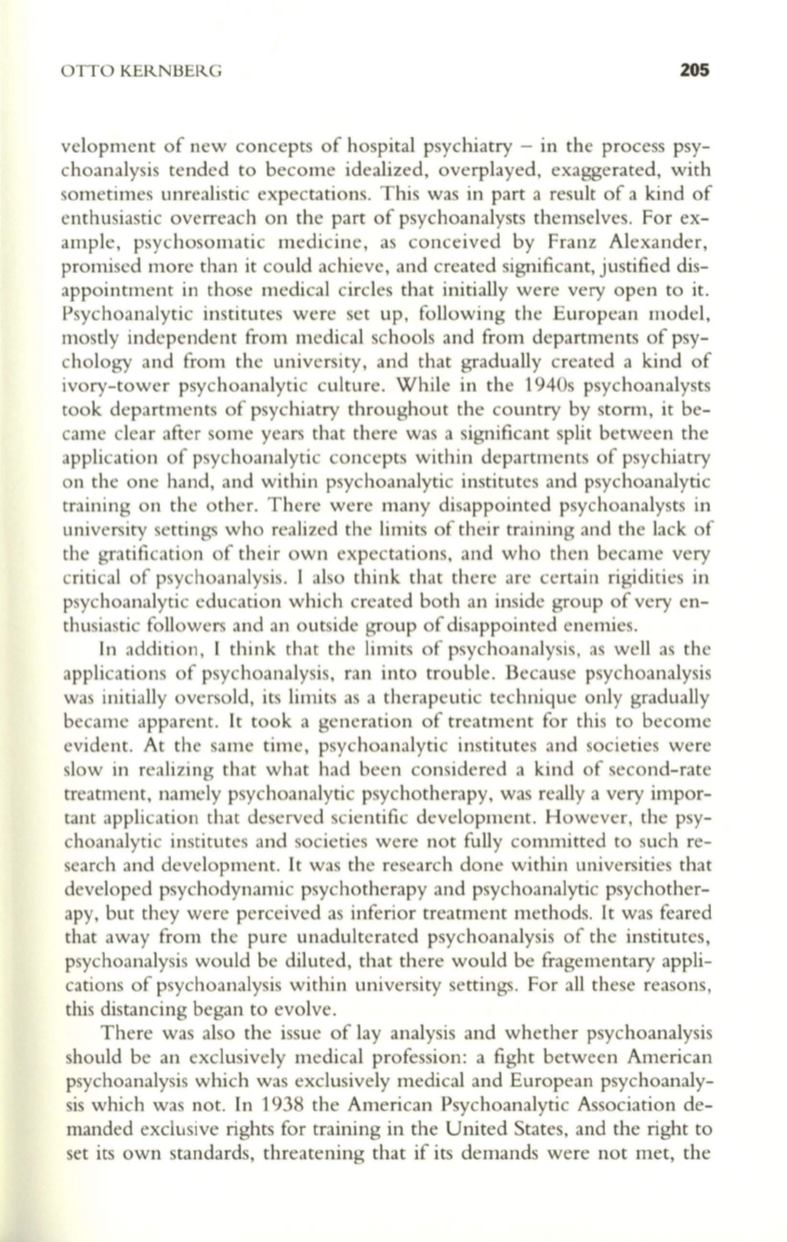
OTTO KERNBERG
205
velopment of new concepts of hospital psychiatry - in the process psy–
choanalysis tended to become idealized, overplayed, exaggerated, with
sometimes unrealistic expectations. This was in part a result of a kind of
enthusiastic overreach on the part of psychoanalysts themselves. For ex–
ample, psychosomatic medicine, as conceived by Franz Alexander,
promised more than it could achieve, and created significant, justified dis–
appointment in those medical circles that initially were very open to it.
Psychoanalytic institutes were set up, following the European model,
mostly independent from medical schools and from departments of psy–
chology and from the university, and that gradually created a kind of
ivory-tower psychoanalytic culture. While in the 1940s psychoanalysts
took departments of psychiatry throughout the country by storm, it be–
came clear after some years that there was a significant split between the
application of psychoanalytic concepts within departments of psychiatry
on the one hand, and within psychoanalytic institutes and psychoanalytic
training on the other. There were many disappointed psychoanalysts in
university settings who realized the limits of their training and the lack of
the gratification of their own expectations, and who then became very
critical of psychoanalysis. I also think that there are certain rigidities in
psychoanalytic education which created both an inside group of very en–
thusiastic followers and an outside group of disappointed enemies.
In addition, I think that the limits of psychoanalysis, as well as the
applications of psychoanalysis, ran into trouble. Because psychoanalysis
was initially oversold, its limits as a therapeutic technique only gradually
became apparent. It took a generation of treatment for this to become
evident. At the same time, psychoanalytic institutes and societies were
slow in realizing that what had been considered a kind of second-rate
treatment, namely psychoanalytic psychotherapy, was really a very impor–
tant application that deserved scientific development. However, the psy–
choanalytic institutes and societies were not fully committed to such re–
search and development. It was the research done within universities that
developed psychodynamic psychotherapy and psychoanalytic psychother–
apy, but they were perceived as inferior treatment methods.
It
was feared
that away from the pure unadulterated psychoanalysis of the institutes,
psychoanalysis would be diluted, that there would be fragementary appli–
cations of psychoanalysis within university settings. For all these reasons,
this distancing began to evolve.
There was also the issue of lay analysis and whether psychoanalysis
should be an exclusively medical profession: a fight between American
psychoanalysis which was exclusively medical and European psychoanaly–
sis which was not. In 1938 the American Psychoanalytic Association de–
manded exclusive rights for training in the United States, and the right to
set its own standards, threatening that if its demands were not met, the


